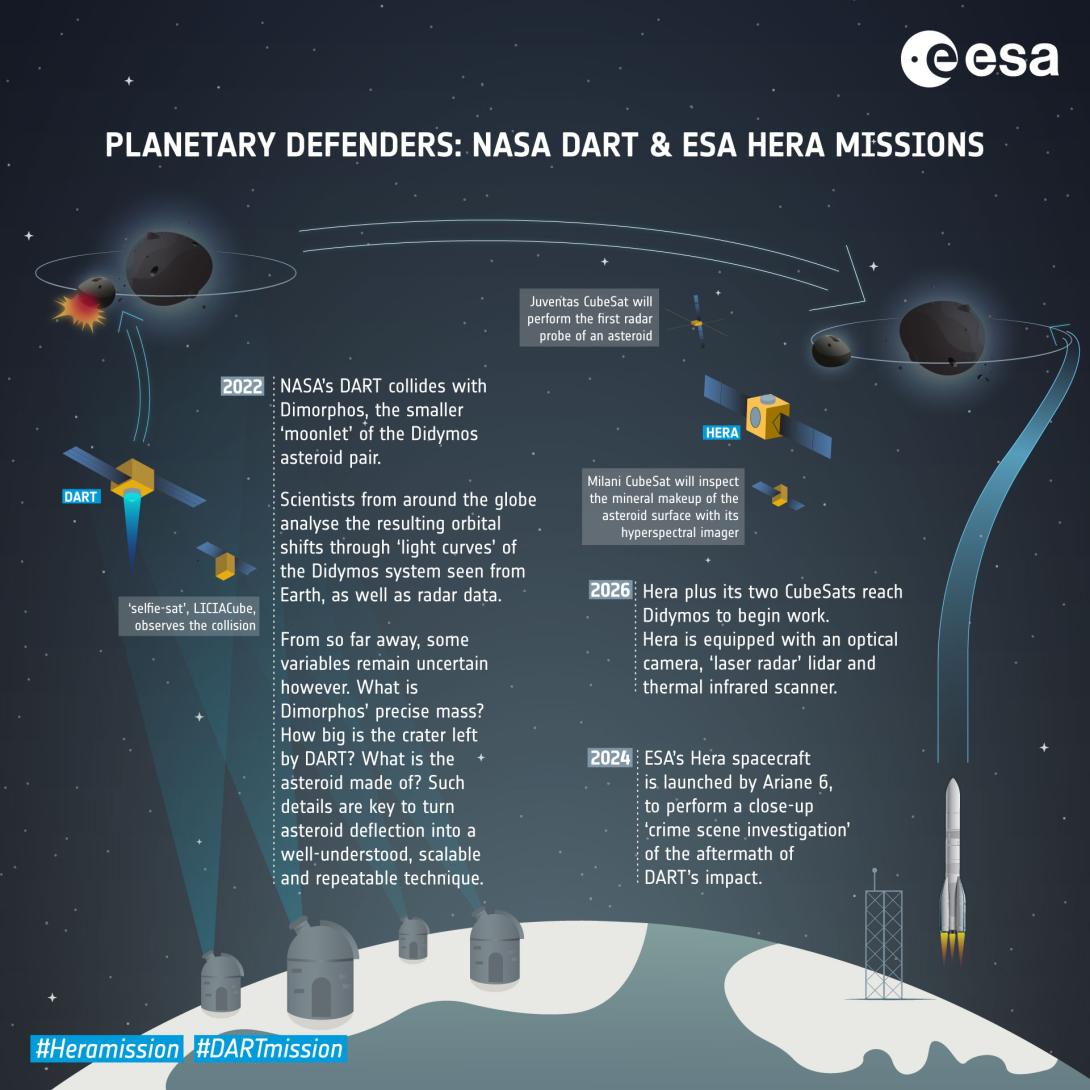Mission
Hera

In the world’s first test of asteroid deflection, ESA’s Hera mission will perform a detailed post-impact survey of the asteroid Dimorphos – the orbiting Moonlet in a binary asteroid system known as Didymos.
NASA’s DART mission will impact the moonlet in September 2022, after which Hera will turn the grand-scale experiment into a well-understood and repeatable planetary defence technique. Hera will also demonstrate new technologies, from autonomous navigation around an asteroid to low gravity proximity operations during humankind’s first rendezvous with a binary asteroid system.
DART will collide with the smaller body of the Didymos binary asteroid at a speed of around 6.6 km per second. While the Didymos asteroid system will maintain its motion around the Sun unperturbed, the collision is expected to shift the orbit of the 160-metre-diameter Dimorphos around its 780-metre-diameter parent Didymos in a small but distinct way – just a fraction of one per cent, sufficient to be measured with Earth-based telescopes and radar.
But observing from across space will still leave multiple unknowns, such as the precise mass of Dimorphos, its makeup and its internal structure – as well as the size and shape of the crater left by DART. So, in October 2024 Hera will launch towards the Didymos system on its journey to investigate the aftermath of DART’s collision up close in late 2026.
With this data, Hera will help turn DART’s impact experiment into a well-understood and repeatable deflection technique – ready to be deployed if an asteroid should ever be spotted heading towards Earth.

New frontiers, new technologies
In September 2020, ESA awarded a €129.4 million contract covering the detailed design, manufacturing and testing of Hera. The contract was signed by Franco Ongaro, ESA Director of Technology, Engineering and Quality, and Marco Fuchs, CEO of German space company OHB, prime contractor of the Hera consortium, at ESA’s ESOC operations centre, which will serve as mission control for the mission. This contract covers the full Hera satellite development, integration and test, including its advanced guidance, navigation and control (GNC) system.
Hera will demonstrate novel technologies and deploy Europe’s first deep-space CubeSats to survey the asteroid close up. Milani will make spectral surface observations, while Juventas will undertake the first-ever radar soundings within an asteroid using an updated version of the radar system carried by ESA’s Rosetta comet mission.
Hera’s European partners
The contract for the development and construction of the Hera mission was awarded to a consortium led by prime contractor OHB System AG in Bremen. The space industry in 17 ESA Member States is involved in the mission:
Germany is tasked with the overall Hera spacecraft design and integration, main navigation cameras, tanks, thrusters, high-gain antenna, reaction wheels, and mass memory unit.
Italy is leading the mission’s power and propulsion subsystems, and is providing the deep-space transponder that will enable the mission’s radio science experiment. Italy is also leading the dust and mineral prospecting CubeSat, named after the late Andrea Milani, distinguished professor and leading asteroid scientist.
Belgium is developing Hera’s on-board computer and software, the brain of the spacecraft, plus its power conditioning and distribution unit – the heart of its electrical subsystem. It is also contributing to Hera’s Japanese-developed thermal imager and the CubeSat operations centre at ESA/ESEC.
Luxembourg is leading the radar-hosting ‘Juventas’ CubeSat and the inter-satellite communication system allowing the two Hera CubeSats to communicate with Earth through an innovative network using Hera as data relay.
Portugal and Romania are developing the laser altimeter which will provide crucial information for the autonomous navigation functions. In addition, Romania is developing the image processing unit, harness and the electrical test equipment (while also contributing to its GNC development).
The Czech Republic is responsible for the full satellite structure, payload software (to command the instruments), independent software validation and ground support equipment for pre-flight satellite testing. It is also providing components for Juventas’ low-frequency radar and data processing software on the second CubeSat.
Spain is developing Hera’s advanced guidance, navigation and control system as well as the deep-space communication system. It is also providing the Juventas gravimeter instrument.
Austria is supporting with mission data analysis and processing.
Denmark is contributing to the Juventas CubeSat and remote terminal unit.
France is providing Juventas’ low-frequency radar, as well as star trackers and support to the CubeSats’ payload operations planning and close-proximity trajectories.
Hungary is supporting scientific calibration of the cameras.
The Netherlands contributes the new deep-space CubeSat deployment system as well as Hera’s hyperspectral imager and Sun sensors.
Switzerland is contributing with structural elements and mechanisms for the solar arrays.
Finland is providing the second CubeSats’ multi-spectral imager and onboard equipment. It is also providing the data processing unit.
Poland is contributing with Juventas’ low-frequency radar deployable antennas.
Ireland is providing an innovative inertial measurement unit for the Hera spacecraft to support deep-space navigation.
ESA Associate Member State Latvia is contributing a time-of-flight detector for the mission’s laser altimeter.
